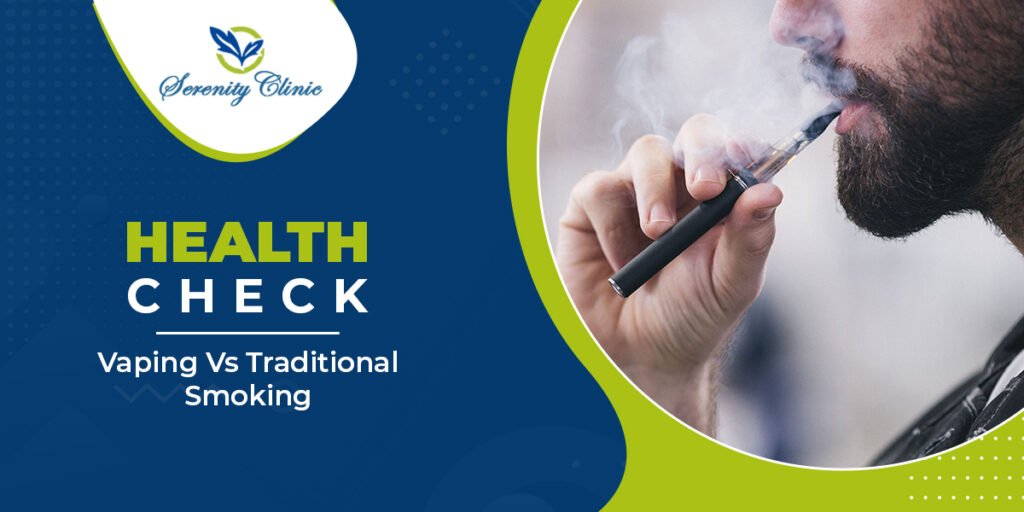As smoking remains a significant public health concern, the rise of vaping has sparked debates regarding its relative safety compared to traditional cigarette smoking. While both methods deliver nicotine and other chemicals to the body, their mechanisms and potential health impacts differ significantly. Let’s conduct a health check to compare Vaping vs. Traditional Smoking, exploring their effects on various aspects of health.
What are the Effects of Traditional Smoking?
Traditional smoking has profound effects on both the individual smoker’s health and the health of those exposed to secondhand smoke. Smoking cigarettes is a leading cause of preventable death worldwide, contributing to numerous adverse health outcomes:
1. Respiratory Effects: Smoking damages the respiratory system, increasing the risk of chronic obstructive pulmonary disease (COPD), emphysema, chronic bronchitis, and lung cancer. It also exacerbates asthma symptoms and increases susceptibility to respiratory infections.
2. Cardiovascular Effects: Smoking significantly elevates the risk of cardiovascular diseases, including heart disease, stroke, peripheral artery disease, and aortic aneurysm. Nicotine and other chemicals in tobacco smoke damage blood vessels, increase blood pressure and promote the formation of arterial plaque.
3. Cancer Risk: Smoking is a leading cause of various cancers, including lung, throat, mouth, esophageal, stomach, pancreatic, bladder, kidney, and cervical cancers. Tobacco smoke contains carcinogens that damage DNA and increase the likelihood of cancer development.
4. Reproductive Effects: Smoking negatively impacts reproductive health, increasing the risk of infertility, erectile dysfunction, pregnancy complications, and birth defects. Pregnant women who smoke are at higher risk of miscarriage, preterm birth, low birth weight, and sudden infant death syndrome (SIDS).
The effects of traditional smoking are wide-ranging and severe, leading to significant morbidity, mortality, and economic burden on society. Quitting smoking is crucial for reducing these health risks and improving overall well-being.
What are the Effects of Vaping?
Vaping, while often marketed as a safer alternative to traditional smoking, is not without health risks. The effects of vaping on health are still being studied, but current research suggests several potential consequences:
1. Respiratory Health: Vaping can irritate the lungs and airways, leading to symptoms such as coughing, wheezing, and shortness of breath. Long-term effects on lung function and respiratory outcomes are still unclear.
2. Nicotine Addiction: Many vaping products contain nicotine, which is highly addictive and can lead to dependence. Nicotine exposure during adolescence can also harm brain development and increase the risk of addiction to other substances.
3. Cardiovascular Health: While vaping is generally considered less harmful to cardiovascular health than smoking, it can still have adverse effects on blood pressure, heart rate, and arterial stiffness, particularly among individuals with underlying cardiovascular conditions.
4. Chemical Exposure: Vaping exposes users to various chemicals, including flavourings, solvents, and toxicants, some of which may pose health risks when inhaled or absorbed into the body.
Overall, while vaping may carry fewer health risks than traditional smoking, it is not risk-free, and the long-term effects are still not fully understood. Quitting vaping altogether is the best way to reduce potential health risks and improve overall well-being.
Is Vaping Better Than Traditional Smoking?
Whether vaping is better than traditional smoking depends on how “better” is defined and the specific context. Vaping is often considered a less harmful alternative to traditional smoking due to several factors:
1. Reduced Exposure to Harmful Chemicals: Vaping involves inhaling an aerosol rather than smoke, which generally contains fewer harmful chemicals than cigarette smoke. This reduction in exposure to toxins and carcinogens may lower certain health risks associated with traditional smoking.
2. Potential for Harm Reduction: Some individuals use vaping as a tool to transition away from traditional cigarettes or to quit smoking altogether. For these individuals, vaping may serve as a harm-reduction strategy, helping them reduce their overall tobacco consumption or quit smoking entirely.
3. Reduced Secondhand Exposure: Vaping produces an aerosol that dissipates more quickly than cigarette smoke, potentially reducing secondhand exposure to harmful chemicals for bystanders.
However, it’s essential to recognize that vaping is not without risks. Vaping still exposes users to nicotine, an addictive substance with potential adverse health effects. Additionally, the long-term health effects of vaping are still not fully understood, and the safety of vaping products can vary widely.
Ultimately, while vaping may offer certain benefits compared to traditional smoking, it is not risk-free. Quitting smoking and vaping altogether remains the best approach for improving health outcomes and reducing associated risks. Individuals concerned about their health should seek support and resources to quit smoking and vaping.
How to Quit Vaping and Traditional Smoking?
Quitting vaping and traditional smoking can be challenging but is achievable with the right approach and support. Here are steps to help individuals quit:
1. Set a Quit Date: Choose a specific date to stop vaping or smoking and commit to it.
2. Seek Support: Reach out to friends, family, or a support group for encouragement and accountability. Consider joining a smoking cessation program or seeking professional help from a healthcare provider.
3. Identify Triggers: Recognize situations, emotions, or activities that trigger the urge to vape or smoke, and develop coping strategies to deal with them without relying on nicotine.
4. Consider Nicotine Replacement Therapy (NRT): NRT products like nicotine patches, gum, or lozenges can help manage withdrawal symptoms and cravings during the quitting process.
5. Stay Active and Healthy: Engage in regular physical activity, eat a balanced diet, and practice stress-reduction techniques like meditation or deep breathing to support overall well-being and reduce cravings.
6. Stay Persistent: Quitting may require multiple attempts, so don’t get discouraged by setbacks. Stay focused on your goal and celebrate each small victory along the way.
Remember, quitting is a journey, and support is available to help you succeed. With determination and support, it’s possible to break free from the grip of nicotine addiction and live a healthier, smoke-free life.








